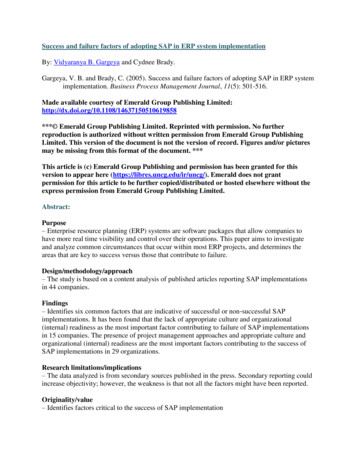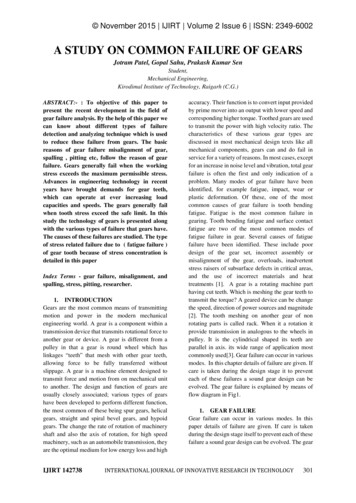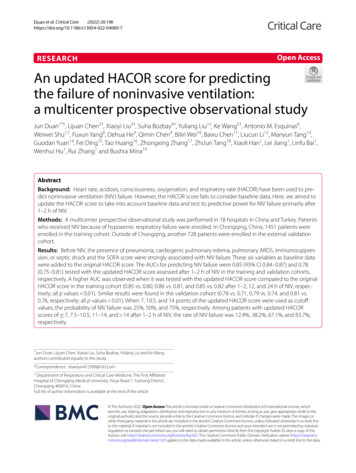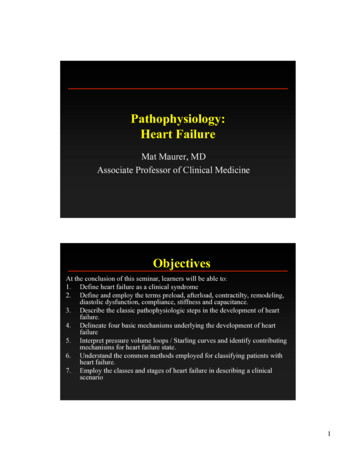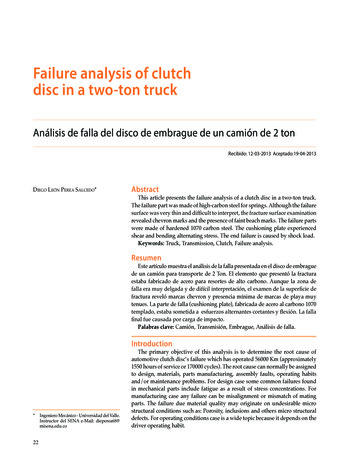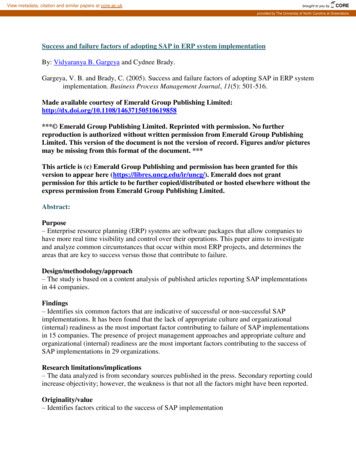
Transcription
View metadata, citation and similar papers at core.ac.ukbrought to you byCOREprovided by The University of North Carolina at GreensboroSuccess and failure factors of adopting SAP in ERP system implementationBy: Vidyaranya B. Gargeya and Cydnee Brady.Gargeya, V. B. and Brady, C. (2005). Success and failure factors of adopting SAP in ERP systemimplementation. Business Process Management Journal, 11(5): 501-516.Made available courtesy of Emerald Group Publishing 8*** Emerald Group Publishing Limited. Reprinted with permission. No furtherreproduction is authorized without written permission from Emerald Group PublishingLimited. This version of the document is not the version of record. Figures and/or picturesmay be missing from this format of the document. ***This article is (c) Emerald Group Publishing and permission has been granted for thisversion to appear here (https://libres.uncg.edu/ir/uncg/). Emerald does not grantpermission for this article to be further copied/distributed or hosted elsewhere without theexpress permission from Emerald Group Publishing Limited.Abstract:Purpose– Enterprise resource planning (ERP) systems are software packages that allow companies tohave more real time visibility and control over their operations. This paper aims to investigateand analyze common circumstances that occur within most ERP projects, and determines theareas that are key to success versus those that contribute to failure.Design/methodology/approach– The study is based on a content analysis of published articles reporting SAP implementationsin 44 companies.Findings– Identifies six common factors that are indicative of successful or non‐successful SAPimplementations. It has been found that the lack of appropriate culture and organizational(internal) readiness as the most important factor contributing to failure of SAP implementationsin 15 companies. The presence of project management approaches and appropriate culture andorganizational (internal) readiness are the most important factors contributing to the success ofSAP implementations in 29 organizations.Research limitations/implications– The data analyzed is from secondary sources published in the press. Secondary reporting couldincrease objectivity; however, the weakness is that not all the factors might have been reported.Originality/value– Identifies factors critical to the success of SAP implementation
Keywords: Manufacturing resource planning Critical success factorsArticle:IntroductionEnterprise‐wide resource planning (ERP) system software packages are highly integrated,complex systems for businesses, and thousands of businesses are running them successfullyworldwide (Koch, 1996). Even companies such as Hershey, JoAnn stores, Whirlpool andSamsonite that have suffered through classic disasters, acknowledge the software packages areable to handle the job. The systems are capable of functioning as advertised; however, companiesrun into costly and sometimes fatal difficulties with the implementation and subsequentmaintenance of these packages.According to The Gartner Group, 70 percent of all ERP projects fail to be fully implemented,even after three years (Gillooly, 1998). Typically, there is no single culprit responsible for a“failed implementation”, and no individual reason to be credited for a successful one. Even thedefinitions of failure and success are gray areas, lending to interpretation. There are generallytwo levels of failure: complete failures and partial failures. In a complete failure, the projecteither was scuttled before implementation or failed so miserably that the company sufferedsignificant long‐term financial damage. Those implementations considered partial failures oftenresulted in tenuous adjustment processes for the company; creating some form of disruption indaily operations. In the same vein, an ERP success can be a complete success – one in whicheverything goes off without a hitch, or one in which there are few alignment problems, resultingin minor inconvenience or downtime. Frequently, these situational circumstances that have to beironed out in the weeks and months after the “go‐live” date are not severe enough to disrupt thedaily operations.There are dozens of vendors of ERP systems. However, the top five ERP system vendors areSAP, Peoplesoft, Oracle, J.D. Edwards, and Baan. SAP has been recognized as the leader withmore than 50 percent of the market (Burns, 1999; Mabert et al., 2000;Stratman and Roth,2002; Vaughan, 1996). Hence, the current study has focused on SAP implementations as aleading example of ERP system implementation.One of SAP's major strengths includes the extensive capability of the software's functionality.Perhaps two of its shortcomings are the complexity of the system and the resultingimplementation. It is widely used in industries such as chemicals and pharmaceuticals (processindustries), and also in oil and gas industries. By making a huge and ongoing investment inresearch and development, SAP continues to strive for increased dominance of the ERP market.Accordingly, developments are underway to gain strength in many other sectors of the economy.There are over 20,000 customers running the SAP software systems today; this equates to 20,000“successful” implementations. Some of these were originally failures, requiring iterative attemptsat making the software work as designed.
In order to determine factors that will indicate early on whether a project will be successful, ordoomed to potential failure, 44 companies that implemented SAP were reviewed. Thesecompanies vary in size, industry and scope of implementation. The research methodologyemployed for the analyses was that of content analysis, which examines the content withinpublished articles, and processes the information contained within them through qualitativeprocesses. The companies analyzed implemented SAP between 1995 and 2000.The next section provides a review of the literature on the implementation of ERP systems. Thethird section of paper describes the research methodology adopted for this paper. The fourthsection elaborates on the findings and describes the factors that play a role in success or failureof SAP implementation. The last section draws some conclusions.Enterprise resource planning systemsAn effective business strategy centers on an aggressive, efficient use of information technology;for this reason the ERP systems have emerged as the core of successful informationmanagement, and the enterprise backbone of the organization (Nash, 2000a, b). A successfulERP system will streamline processes within a company and improve its overall effectiveness,while providing a means to externally enhance competitive performance, increase responsivenessto customers, and support strategic initiatives (Sandoe et al., 2001). The benefits of ERPsystems, once the pains of implementation are over, appeal to companies.There are many factors to be considered in making the decision of whether to implement an SAPsystem or not. The technical aspect is not the only factor that needs to be considered;unfortunately many companies have not seen this until it was too late. The financial commitmentis substantial; therefore, chief executive officers and senior executive teams must be deeplyinvolved. Simply put, ERP is not intended for every business. When considering the decision toinvest in an ERP system, a business case must be developed to provide an understanding of ERP,and to formally assess the benefits that the company – as an individual entity apart from itscompetitors – can expect to achieve. The analysis must consider not only the obviouscost/benefit analysis, but also the non‐financial factors. Non‐financial benefits includeinformation visibility and flexibility (Sandoe et al., 2001). A more complete listing of tangibleand intangible benefits is provided in Table I. ERP implementation costs are incurred in threeareas: software, hardware, and personnel. The personnel (or the human resources) cost is by farthe largest and most expensive, but at the same time has been the area given the least amount ofconsideration. The software and hardware costs are often easily quantifiable; however, the“human” cost is not (Davenport, 2000).There have been a few papers recently published on the factors contributing to ERPimplementation. Dong (2001) proposed a conceptual model exploring the impact of topmanagement on enterprise systems (ES) implementation. Aladwani (2001) described anintegrated, process‐oriented approach for facing the complex social problem of workers'resistance to ERP systems. Huang and Palvia (2001) proposed ten factors (at thenational/environmental and organizational level) concerning ERP implementation by making acomparison of advanced and developing countries. The national/environmental factors identifiedby them are economy and economic growth, infrastructure, regional environment, government
regulations, and manufacturing strengths. They also noted that information technology maturity,computer culture, business size, business process re‐engineering experience, and managementcommitment are the organizational level factors. Huang and Palvia (2001) did not categorize thefactors into those that contribute to success and those that contribute to failure.Nah et al. (2001), based on a study of earlier papers (most of which were normative/prescriptivein nature), identified 11 factors that were critical to ERP implementation success. The 11 factorsnoted by them are1. ERP teamwork and composition;2. change management program and culture;3. top management support;4. business plan and vision;5. business process re‐engineering and minimum customization;6. effective communication;7. project management;8. software development, testing, and trouble shooting;9. monitoring and evaluation of performance;10. project champion; and11. appropriate business and information technology legacy systems.None of the above papers were based on any primary empirical data (in the form of survey orcase research) or secondary data (content analysis of reported cases or surveystudies). Themistocleous et al. (2001), based on a survey of 50 respondents, underscored theneed for integration of existing systems with ERP applications in ERP implementation. Stratmanand Roth (2002)through a questionnaire survey of 79 North American manufacturing users ofERP systems identified eight generic constructs (strategic information technology planning,executive commitment, project management, information technology skills, business processskills, ERP training, learning, and change readiness) that are hypothesized to be associated withsuccessful ERP adoption. However, the works of Nah et al. (2001), Themistocleous etal. (2001) and Stratman and Roth (2002) do not focus on factors of failure.Umble and Umble (2001) expressed their views on 14 success factors (definition of businessgoals, establishment an executive management planning committee, thinking of implementationas research and development, use of cross‐functional teams, stocking implementation teams withthe best and smartest workers, alignment of everyone's interest by giving mid‐level management
hands‐on responsibility, constant communication with teams and end users, excellent projectmanagement, choice of partners, extensive education and training, management with data,measurement of the right things, establishment of aggressive achievable schedules, and no fearfor change) and nine failure factors (top management failure, poor project management, lack ofeducation and training, people do not want new system to succeed, unrealistic expectations aboutimplementation, inaccurate data, attempt to automate existing redundant or non‐value‐addedprocesses, mismatch between the business and ERP system selected, and technical difficultiescan lead to implementation) in ERP implementation. It appears that the work of Umble andUmble (2001), though normative/prescriptive for failure and success of ERP implementations, isnot based on a systematic analysis of ERP implementations in different organizations.In summary, the review of the literature shows that there is not much of research done onidentifying the factors of SAP implementation success and failure based on the content analysisof published articles and books. That is the main thrust of the current work.Research methodologyThe primary purpose of this research is to find out the factors that contribute to success andfailure in adopting SAP. Content analysis has been be used to infer from published articles thefactors that lead to success or failure for an ERP project, specifically SAP implementations.Content analysis is “fundamentally empirical in its orientation, exploratory, and predictive in itsintent” (Krippendorf, 1980). This research technique is often used to determine the bias betweentwo sides of an issue (for instance, labor unions versus manufacturers), to determinequantitatively whether readers can and are being influenced by the manner in which an article iswritten, or even where it is placed in a publication. The facts of a successful or unsuccessfulimplementation are fairly straightforward – the project succeeded or it did not as measured byfinancial standards, or by operational standards. Content analysis was used on this level as a toolto analyze the material and make recommendations that will provide knowledge, new insights,and a practical guide to future actions (Krippendorf, 1980). This content analysis is not to swaythe reader into forming an opinion of the outcome, only to indicate specific factors that relate tothe outcome.The data generating and data reduction methodology involved analyzing textbooks, journals andmagazine articles for information related to companies that have implemented SAP software.Companies that implemented SAP between 1995 and 2000 period were analyzed. Articles werechosen through a library database, using search keywords of SAP, ERP, SAP success, SAPfailure, and implementation. Companies were removed if the supporting articles only detailedwhat happened after implementation or gave no details surrounding the success or failure. Datainference centered on mapping and analyzing the factors stated within published articles. Theanalysis phase involved determining the frequency of particular factors from within the entirepopulation. The structure of the research allowed for a company to cite more than one factorrelating to success or to failure. In all, more than a 100 articles and books were searched. Asample of those includes Atkinson (1999), Business Wire (2001), Campbell (1999), Jesitus(1997), Levin (1998), O'Brien (1999), Osterland (2000) and Wheatley (2000).
The content analysis showed that SAP implementation successes accounted for two‐thirds (29 inabsolute number) of the companies studied, and failures accounted for the remaining one‐third(15 firms). Failed implementations are often more difficult to research, as companies tend tokeep problems hidden from public view as much as possible to avoid embarrassment and/orpotentially serious financial repercussions. The factors were categorized into six logicalgroupings.Factors and findings from content analysisBefore beginning an ERP implementation, that is even before a vendor is chosen, much planningand thought must go into the process. By utilizing the methodology of content analysis, it waspossible to identify terms that occurred within the research, and quantify their frequency. Thecompanies evaluated within this research were mapped against the criteria, and inferences aredrawn based upon the information.All the factors were lumped into six logical groupings. These factors either led to the success ofan implementation project, or to its failure. As all factors listed within an article were evaluated,one would expect companies to often identify more than one factor as being primary tosuccess/failure. The companies and relative data are listed in Tables II and III.As one would expect, more than one factor was listed as contributing to the outcome of a project.The 44 companies listed a total of 81 occurrences of these factors. For the 29 firms where SAPwas “successfully” implemented, the six factors were listed 60 times and the in the 15 firmswhere SAP implementation was “unsuccessful” the six factors were listed 21 times. TableIV shows a listing of each factor, and its relative percentage of frequency. The followingparagraphs elaborate on the six factor groups.
Factor 1: worked with SAP functionality/maintained scopeA crucial part of working with the SAP functionality is the ability to streamline operations.When implementing a system, many organizations fail to specify their organizational objectives.Job skills are raised by the requirements of the new, post‐implementation company. Idiosyncratic
ways of doing business, which were manageable, although most likely inefficient, under the “oldsystem”, are no longer tolerated. Companies that do not understand these issues early on willface serious problems (Davenport, 2000). Successful companies have recognized the importanceof “cleaning up” their operations, which will allow them to implement “vanilla” SAP – withminimal customization.Even though the so‐called “vanilla” approach is adopted by two‐thirds of implementingcompanies, some customization will always be required in order to meet individual needs(Themistocleous et al., 2001). The key, it appears, is to know just how much to customize.Colgate‐Palmolive, a 9 billion consumer products manufacturer, implemented SAP in 41countries in 1998. Installing an integrated computer system at this level of magnitude would be adaunting project for anyone. A direct quote from Ed Toben, CIO of Colgate‐Palmolive, puts theplan into clear terms: “This is complicated stuff, you have to do anything you can to simplify it”(Stedman, 1999). The ability to implement SAP with minimal customization requires assistancefrom several other factors, primarily streamlining operations and re‐engineering the business –both of which will help the organization to run in a more straightforward manner. Thoroughplanning is also a close partner, as it is threaded through the plans from scope to budgets.Scope is the initial “blueprint” of an implementation plan. Within this original plan, budgetaryand resource needs are established. During the course of the project, it can be easy, oftentransparently so, to become so involved in details that additional responsibilities or requirementsare added or affected. Suddenly, but often too late, the realization comes that the project is avictim of “scope creep”. The ability to maintain scope is closely related to planning, and it ispossible to achieve for companies both large and small. Colgate‐Palmolive Company also listedscope maintenance as a factor to their success (Geishecker, 1999). Maintaining scope is just asimportant for small companies as it is for large organizations. The approach for “rolling out”their implementation is another very important consideration under the SAP functionality/scopeumbrella.Much has been said about “big bang” approaches and gradual rollout of modules within acompany. There is no evidence that any one way is better than another as a whole; however, oneapproach will be better for companies on an individual basis. There have been many widelypublicized “big bang” successes, and many failures. The same is true for gradual (phased)rollouts, although these generally are not headline‐grabbers. Chevron, a 43 billion oil giant,attributes a phased rollout to their success. They successfully implemented SAP and replacedover 250 legacy systems on a global basis using the phased approach. By implementinggradually, they were able to catch any “bugs” before moving forward, thereby avoiding anycatastrophic, system‐wide problems (Geishecker, 1999). Amoco, Merisel and Owens Corning areexamples of other companies who chose to take a gradual rollout approach, and who consider thedecision a contributor to their success. Home Depot has successfully implemented severalmodules around the world, and utilized the phased rollout approach (Mearian, 2000). The phasedrollouts take longer to complete, and are more expensive due to the additional time commitment;however, the approach does offer a reduced business risk (Davenport, 2000). Only one of thecompanies analyzed cited SAP core functionality as a problem. Sobey's, an 89 million Canadiangrocery chain, did not feel SAP could handle its requirements, and prematurely abandoned the
implementation process. For the most part, companies, even the ones who experiencedmiserable, expensive failure, agree that SAP will perform as advertised.Factor 2: project team/management support/consultantsThe successful project team is cross‐functional, consisting of the most knowledgeable people inthe organization (Nah et al., 2001). The team, at all times, must be dedicated solely to theproject, and have no other responsibilities within the company. Lockheed Martin, a leadingaeronautical group, stated one of its keys to success was “assembling a team capable of makingand executing” the changes required (Stedman, 1999).A successful implementation is only achievable when high‐level executives have a strongcommitment to the project (Davenport, 2000). The attitude of senior managers will affect notonly the flow of funds and information to the project, but also the subordinates view the project,its future impact upon the company as a whole, and its impact upon the employees as valued andcapable individuals. Fujitsu Microelectronics, an international manufacturer of semiconductors,successfully completed its ERP implementation within ten months. They attribute success in partto top management support (Zerega, 1997). During the entire project, company managementprovided substantial incentives to team members, and ensured that internal communicationchannels were open at all times. GTE completed an 11‐month integration not only on time andwithin budget, but also without the aid of an outside consulting firm. Again, top managementwas a primary factor cited for their success (Caldwell, 1998).Senior management at Farmland Industries showed its support of the process by providingbonuses to employees and consultants. The project members were charged with ensuring that notonly technical goals were met, but also that the “people” element and business changes weretaken care of at the same time (Davenport, 2000). Farmland had the foresight to understand thatan ERP system was not only a significant technical change, but also a massive cultural change.As stated earlier, and reinforced with these examples, the ERP software can be designed to workperfectly well, but lacking top management support, the project is destined to fail. Seniormanagement has the authority and responsibility to support the project internally throughincentives and bonuses, and externally through maintaining open and effective communicationchannels and a reassuring, positive attitude. By constantly exposing the positive benefits andresults of such an endeavor throughout the implementation process, success is much more likelyto occur.
Factor 3: internal readiness/trainingThe “people element” and training aspect of an ERP implementation have historically receivedthe least amount of attention. The paradox of this is that when this factor is ignored ordownplayed, primarily because it does not have the largest quantifiable benefit, expenses aregreatly increased in the long run. By treating resource training with little regard and financialsupport, it is not hard to realize the reality of delay, confusion and financial ruin that may result.Some companies insist on assigning a fixed cost or percentage to the training effort, regardless ofneed or variable conditions. This mistake has certainly been the root cause of many failedimplementation attempts. Fortunately, it has also been a source for others to learn from suchexperiences and avoid repeating the mistake.The people element must be handled on two levels. At one level, employees must be trained onthe new system in order to use it to continue day‐to‐day operations. The second level iseducational exposure. Managers must know and understand the implications of the system, andmust come to a consensus about the changes that will take place. If they agree that change isnecessary and possible, they can be charged with disseminating this information to theirsubordinates. If managers are not in agreement or collaboration, then there will be no“enthusiasm”, or buy‐in, and there may even be active resistance (Davenport, 2000). Thereinforcement of a “team environment” is critical to the overall success of an ERPimplementation. Members of the project team should be encouraged to support each other andwork toward common goals. This also leads to a “cross‐pollination” effect, resulting in a morecollaborative and self‐sufficient mix of talent and responsibilities.Not unexpectedly, the most common failure factor reported was that of “readiness for change”.Implementing an ERP system completely changes the culture within an organization, and manycompanies have found themselves hard pressed to accomplish this successfully. Unisource, a 7billion corporation, scuttled its implementation plans due to “internal problems”. The companywas unable to deal with the levels of cultural change that would have to take place in order to besuccessful under an ERP system (Stein, 1998).Many companies have been guilty of making simplistic assumptions of how an implementationwill affect the culture within their organization. Culture changes do not occur magically, andmust be handled with the utmost care and precision (Davenport, 2000). These changes directlyrelate to the human cost element, or human psyche. If people are not ready or willing to change,change simply will not occur. All managers must be charged with the responsibility ofcontrolling worker anxiety and resistance to the ERP system (Aladwani, 2001).Factor 4: deal with organizational diversityOrganizations have many cultures. Individual branches of the same organization have their ownways of doing things, and each function/department operates with different procedures andbusiness requirements. Not unexpectedly, the larger, more global companies cite their diversityas an obstacle to success. Individual units and groups are often companies of their own right, anddo not wish to be assimilated into one corporate culture. “Re‐engineering” of the business isrequired here, both on the “people” level, and on the operational level. This organizational
diversity differs from factor #1 (worked with SAP functionality/maintained scope) in that thecompany changes its culture, not just its processes.Farmland Industries, a 10.7 billion farmer‐owned cooperative wanted to ensure that theirendeavor would be successful. Before launching their implementation, they interviewed overthirty other SAP users, in an attempt to “learn from the mistakes of others”. The knowledgegained allowed them to re‐engineer their business before beginning the process, and resulted in asuccessful implementation (Stedman, 1999). It appears to be more critical for large, diverseorganizations to re‐engineer their processes and remove idiosyncrasies – both cultural andprocedural – before taking on a project. Amoco ( 33 billion, oil/petroleum) and Chevron ( 43billion, oil/petroleum) painstakingly re‐engineered their companies. The concept of re‐engineering the business is not simply to fit the software. Before any company can be linkedeffectively to world‐class supply chains, their internal processes must be world‐class (Ptak,2000). Chemical giant E I DuPont, scuttled its SAP implementation after determining that itsorganizational units were too diverse, feeling that it would be too difficult for them to attempt tore‐engineer their processes (Koch, 1996). On the other hand, it is possible to overcome thisproblem. Many large companies, Amoco and Chevron, for example, successfully re‐engineeredtheir business and overcame the problem of organizational diversity.Factor 5: planning/development/budgetingPlanning a sophisticated ERP project should not be taken lightly or with little forethought. Asmentioned before, there are enormous potential costs associated with such an undertaking. Inaddition to the high costs paid out before the go‐live date, there can and have been majorexpenses incurred by companies that were unable to fully develop a comprehensive plan.Planning should be closely identified with maintaining scope during an implementation. Costoverruns and developmental delays are costly, sometimes fatal results of ineffective planning.Home Depot, Lockheed Martin, and Mead Corporation are some examples of companies thatattributed their success to planning. Lockheed planned a well‐equipped team to do theimplementation, allowing them to make a solid plan for achieving their stated goals. MeadCorporation, a large pulp and paper manufacturer researched the notorious Hershey Foodsimplementation in an effort to learn what they would need to do differently in order to succeed,or more specifically, to avoid failing. Consequently, Mead successfully implemented nineseparate modules simultaneously within their operations (Shaw, 2000).Developmental delays with ERP implementations were more of an issue during the Y2Kreadiness period, and some companies in the midst of an implementation were forced to scuttlethe operations and make quick fixes to their legacy systems. For example, this was a primaryissue with Nash Finch, a national food wholesaler (Mearian, 2000). Delays, however, can causeany operation to be scratched if the senior managers feel they should no longer, financially orotherwise, support a project that may never get off the ground within a reasonable period of time.Developmental delays can also lead to resource a
Success and failure factors of adopting SAP in ERP system implementation By: Vidyaranya B. Gargeya and Cydnee Brady. Gargeya, V. B. and Brady, C. (2005). Success and failure factors of adopting SAP in ERP system implementation. Business Process Management Journal, 11(5): 501-516. Made available courtesy of Emerald Group Publishing Limited:
